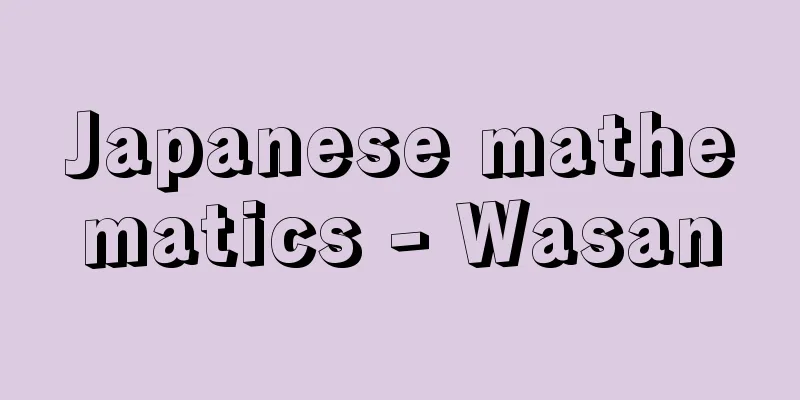Japanese mathematics - Wasan

|
Mathematics that developed uniquely in Japan during the Edo period. Some refer to all mathematics in Japan from the early Edo period onwards as wasan, while others refer to mathematics from Seki Takakazu onwards, which began to develop uniquely in Japan. The term wasan is in contrast to Western mathematics. When Western mathematics was imported around the time of the Meiji Restoration, it was called Western mathematics, and in contrast, traditional Japanese mathematics was called wasan, so historically it is a relatively recent term. The word wasan did not exist in the Edo period. Incidentally, Wasan scholars in the Meiji period called wasan "wasan," and the term "wazan" is a fairly recent development. Historically, Japanese mathematics has been influenced by foreign countries three times. The first time was shortly before the Nara period, the second was before the Edo period, at the end of the Muromachi period, and in both cases mathematics was introduced from China. The third time was shortly before the Meiji Restoration, when mathematics was introduced from the West. All three times have in common that the introduction of mathematics greatly contributed to the cultural development of the following era. [Shinichi Oya] The introduction of counting sticks and multiplication tablesThe first characteristic of the introduction of mathematics was the introduction of counting sticks as a calculating tool and multiplication tables for multiplication. The multiplication tables were very well received and became widely used by the general public. Traces of this can be seen in the Manyoshu, where there are several examples such as "81" written as "kuku" and "16" written as "shishi," or conversely, "25" written as "too." The multiplication tables were not forgotten even after that. Even during the Heian period, from the Kamakura period to the Muromachi period, when mathematics had completely declined, tables of multiplication tables can be found in Kuchizusami, Shugaisho and other works. During the Nara period, mathematics was studied at universities. Teachers were San Hakase (mathematical experts), and students were called Sansei (mathematical experts). The textbooks used there were similar to those from the Tang Dynasty in China, but there were some differences. This is said to be because they were based on the Korean education system. The level was quite high, and students studied "Nine Chapters on Mathematics" and other advanced mathematics. However, in the middle of the Heian period, the position of San Hakase became hereditary, academic ability declined, and it became merely a title. From the Kamakura period to the Muromachi period, mathematics declined completely, and only simple calculations and mathematical games were practiced. [Shinichi Oya] The introduction of the abacusTowards the end of the Muromachi period, commerce and industry flourished, and the need for mathematics also increased. During this period, mathematics was introduced from China for the second time. The characteristics of the mathematics that was introduced this time were the abacus as a calculating tool and the "wari-sei" (division tables) used for division with the abacus. These were apparently brought back by trading ships that traveled to China at the time. A few other mathematics books for the abacus were also brought back. Just before the Edo period, the need for calculations became very strong. As a result, abacus-like schools were established in the Kyoto and Osaka areas. There, abacus calculations and simple problems using the abacus were taught. The problems dealt with there were mainly traditional Japanese mathematics that had existed up until that time. Mori Shigeyoshi's Warizansho (1622) includes the above-mentioned abacus calculation method and traditional Japanese mathematics. Several mathematics books from the same period remain, but their contents are more or less the same. The next mathematics book published was Yoshida Mitsuyoshi's Jingoki (1627). This book was modeled after Sanpo Toso (1593), a systematic abacus mathematics book introduced from China, and was far more systematic and much more voluminous than Warizansho. Although they both used the abacus, it can be said that Warizansho concluded old mathematics and Jingoki began new mathematics. This "Jinkoki" includes abacus calculation methods (with illustrations), various calculations for daily use, calculations for large numbers, mathematical games, etc., and was very well received and went through many editions. The author, Mitsuyoshi, updated the content with each edition. About 10 years after the first edition of "Jinkoki" was published, Imamura Chisho's "Jugairoku" (1639) was published. This was a high-level book that contained only purely mathematical materials, whereas "Jinkoki" focused on various calculations for daily use. At that time, the number of mathematics researchers was increasing so much that such books were in demand. Perhaps inspired by this, Yoshida Mitsuyoshi published a completely new edition of "Jinkoki" (1641) two years later. This book contains many large numbers, but its most distinctive feature is that it contains 12 problems without solutions at the end of the book, challenging researchers to answer them. Such problems are called "preferences" or "Idai." People who studied these problems published their solutions in their own books, and at the same time added their own Idai to their own books. This succession of Idai showed rapid progress in Japanese mathematics. [Shinichi Oya] Tengenjutsu and TenkanjutsuAs new problems were created one after another through the succession of the remains, the problems quickly became more difficult in a short space of time. As a result, problems that could not be solved by the abacus alone were also created. Problems that can be solved by the abacus are generally limited to those that are within the scope of modern arithmetic. The highest level of book that deals with this scope is Yoshinori Isomura's "Sanpo Ketsugisho" (1661). The 100 remains in this book are extremely difficult and seem impossible to solve with an abacus, but Isomura was a master, and in later years he solved these problems within the scope of arithmetic. However, this was beyond the reach of ordinary people. Many people began to look for new weapons to solve difficult problems. At this time, the Chinese book "Sangaku Keimo" (1299) caught people's attention, and a method called Tengenshu described at the end of this book was described. Tengenjutsu is a kind of instrumental algebra that uses calculating sticks to solve problems. Many mathematicians have tried to understand this method, and the first research group from Osaka, including Masakazu Hashimoto (date of birth and death unknown) and Kazuyuki Sawaguchi (date of birth and death unknown), made the method their own. Kazuyuki Sawaguchi used Tengenjutsu to solve the problems in the Sanpo Kekisho in his Kokin Sanpo-ki (1671). Tengenshu uses an arrangement of calculating sticks to represent equations, but there were various restrictions. One of these restrictions was that the number of unknowns was limited to one. This made formulating the equations itself extremely difficult. In fact, the 15 problems in the Kokin Sanpoki were already difficult to solve using Tengenshu. It was Seki Takakazu who overcame this difficulty. He came up with the idea of writing down the process of formulating the equations on paper. In this way, any number of unknowns were acceptable, and one unknown could be removed from many equations one by one until a single equation was created. This was much easier than creating an equation with a single unknown from the beginning. This method of written calculation later came to be known as Tenzanjutsu. Seki used this method to publish Hatsubizanpo (1674), a book that solved the problems in the Kokin Sanpoki. However, this book described the calculations after the creation of a higher-order equation with one variable, but did not describe the process of creating a higher-order equation with one variable from simultaneous equations, which led to a debate at the time about its validity. As a result, his disciple Takebe Katahiro explained Seki's method in "Hatsubisanpo Endan Genkai" (1685) in later years. This led to the method of written calculation being known to the public for the first time. This dot-and-dash technique is exactly the same as Western algebra, except for the symbols. The advantage of introducing written calculation is not just that it made it easier to formulate equations. It made it possible to handle types of mathematics that could not be handled with abacus or calculating sticks. As a result, the scope of mathematics became extremely wide. It was thanks to written calculation that it became possible to study everything from equation theory, determinants, permutations and combinations in Japanese mathematics to calculus. For the reasons mentioned above, there are claims that the term "Japanese mathematics" should be limited to mathematics after Seki Takakazu. [Shinichi Oya] Study of the CircleBesides the system of algebra, that is, equations, theories of equations, determinants, etc., the study of circles was what interested Japanese mathematicians the most. Problems about circles appear in the posthumous themes of the Jinkoki, and many mathematicians were interested in them. Prior to Seki Takakazu, Muramatsu Shigekiyo (?-1695) had studied pi in Sanso (1663), but Seki Takakazu developed this work and introduced the idea of limits. However, like Muramatsu, Seki used numerical values for his calculations, and was therefore unable to see the final result of each successive calculation, and was therefore unable to find the formula for pi. It was Takebe Katahiro who improved on this method, calculating pi using characters. Using characters made it possible to see the results of each successive calculation, and the law could be found, which resulted in pi being calculated as the sum of an infinite series. The study of circumferences, circular arcs, and circular products that followed was called "enri." Enri is often said to have begun with Seki Takakazu, but the accepted theory is that in the strict sense, Enri began with Takebe Katahiro. Takebe's pupil was Matsunaga Yoshihiro, who further advanced the study of Enri. Matsunaga's pupil was Yamaji Nushizumi, and Yamaji's pupil was Ajima Naonobu. Ajima developed Enri once more, making it equivalent to Western definite integrals. Wada Yasushi developed this once more, creating an Enri table equivalent to a definite integral table, making calculations of Enri extremely easy. Besides Takebe Katahiro, Seki Takakazu's pupils included Araki Murahide (1640-1718). Although Takebe was more academically gifted, Araki is officially considered Seki's successor. Matsunaga Ryosuke was a pupil of both Araki and Takebe, and the two schools were unified by Matsunaga. Matsunaga then organised the work of the Seki school and organised it into a system. Matsunaga's pupil Yamaji Nushiju established a licensing system and systematically organised the Seki school. It is believed that the term Seki school was first clearly coined around the time of Yamaji. When the development of research in mathematics reached a certain level, the idea of organizing it arose, and a trend also emerged to find a way to teach it educationally, that is, to write a textbook. Arima Yoriyuki, a disciple of Yamaji Nushizumi and the lord of Kurume in Kyushu, wrote "Shūki sanpo" (1769) under the name of his retainer. This was an excellent textbook, and it is said that this book made the Seki school of tenzanjutsu accessible to the general public. Originally, Japanese mathematics textbooks were a kind of problem collection. Therefore, detailed explanations were not written, and the system was to help students understand the principles by solving problems arranged from easy to difficult, and a good textbook was one in which appropriate problems were carefully arranged. In that respect, "Shūki sanpo" was well-made, and later people competed to solve its problems, leading to the creation of many different commentaries. Another disciple of Yamaji Shuju, Fujita Sadasuke, wrote a textbook called "Seiyo Sanpo" (1781). This book is also well-known for its quality. The fact that two students of the same school wrote similar textbooks at the same time indicates that the mathematics of the Seki school had reached a certain stage, and at the same time indicates that the number of students of mathematics had increased. After the above-mentioned movement to establish the lineage, it began to develop again under Yasushima Naoen, a fellow student of Fujita Sadasuke. Yasushima was an original scholar, and Fujita respected him. Yasushima's student, Kusaka Makoto, was said to have been a skilled professor, and he had many famous students, including Wada Yasushi. The development of Japanese mathematics reached its peak under Wada. In this period, the spread of Japanese mathematics became even more widespread. Until then, scholars who were famous for Japanese mathematics were people who lived in Kyoto, Osaka, or Edo, but around this time, famous scholars began to appear in the provinces as well. These people sometimes went to Edo to receive instruction when they had the opportunity, but most of them studied in the area where they lived. There were many cases of students receiving instruction by mail, that is, correspondence education. This method involved copying mathematics books (mostly manuscripts) that were sent to them and studying them. There were also Japanese mathematicians who traveled around the provinces. It was a kind of warrior training in which one would go to a place, visit a Japanese mathematician, and if he was better than oneself, learn from him, and if he was inferior, teach him. As Japanese mathematics became more widespread, more and more people began to study from books rather than directly studying under a teacher. This led to some people finding traditional textbooks inconvenient. Rather than solving each problem by themselves, they began to require the problems to be solved in a book. This was the basis for the emergence of self-study books. This is how books such as Matsuoka Noichi's (1737-?) Sangaku Keiko Taizen (1809), Aida Yasuaki's Sanpo Tenshoho Shinan (1810), Sakabe Kohan's Sanpo Tenzan Shinanroku (1815?), and Hasegawa Hiroshi's Sanpo Shinsho (1830) were created. [Shinichi Oya] The popularity of mathematical tabletsAs the number of people studying Wasan increased in this way, some people began to study it as a hobby. This even changed the content of Wasan. The number of complicated problems that Fujita Sadasuke dismissed as "useless and useless" increased. This was spurred on by the popularity of Sangaku (mathematical tablets). Sangaku, or votive plaques of mathematics, began as votive plaques with the problem or answer written on them that would be hung at shrines and temples as a way of expressing gratitude to the gods and Buddhas when one came up with a good problem or found the answer to a difficult problem. Eventually, they came to be similar to iidai (a type of posthumous plaque), which poses or answers difficult problems. This played a considerable role in the development of Wasan, but later it came to have a stronger meaning as a form of advertising to promote oneself or one's school. This led to the creation of needlessly complicated problems with complex figures. This deviation from the true essence of mathematics was also the cause of Wasan's criticism in later generations. However, this only applied to second- and third-rate scholars, and the scholars who were the mainstream of wasan always walked the correct path and advanced wasan up until the Meiji Restoration. The fact that wasan fell into disuse in the Meiji era did not have any inherent problems with wasan itself, but rather was due to the fact that Western mathematics was more convenient for studying Western science and technology. [Shinichi Oya] "The History of Mathematics in Japan before the Meiji Period, compiled by the Japan Academy, 5 volumes (1954-1960, Iwanami Shoten)" ▽ "Introduction to Japanese Mathematics, by Shinichi Ohya (1987, Nippon Hyoronsha)" [Reference] | | | |Division and multiplication are explained in detail as division and multiplication, with diagrams of an abacus included. This is the most widely used version of "Jinkoki" by Mitsuyoshi Yoshida. Owned by the National Diet Library . "New Edition of Jinkoki" Source: Shogakukan Encyclopedia Nipponica About Encyclopedia Nipponica Information | Legend |
|
江戸時代、日本で独自に発達した数学。江戸時代初期からのわが国の数学をすべて和算という場合もあり、日本独自の発達を始めた関孝和(たかかず)以後の数学をいう場合もある。和算ということばは洋算に対するものである。明治維新前後、西洋の数学が移入されたとき、これを洋算とよび、これに対して日本古来の数学を和算と称したもので、歴史的には新しい名称である。江戸時代には和算ということばはない。なお、明治時代の和算家は和算を「わさん」とよんでおり、「わざん」という呼び方はごく最近のことである。 歴史的にみると、日本の数学は3回にわたって外国の影響を受けている。第1回は奈良時代の少し前、第2回は江戸時代の以前、室町末期で、いずれも中国から数学が移入された。第3回は明治維新の少し前で、これは、西洋から数学が移入された。3回とも、それらの数学の移入が、それに続く時代の文化の発展に大きく寄与したという点では共通している。 [大矢真一] 算木と九九の渡来最初の数学の移入の特徴は、計算器具としての算木(さんぎ)と掛け算のための九九の渡来である。九九は非常に歓迎され、広く一般に普及した。その痕跡(こんせき)は『万葉集』にもみえている。すなわち、そこでは「八十一」と書いて「くく」と読ませ、「十六」と書いて「しし」、あるいは逆に「二五」と書いて「とお」と読ませるなどの例がいくつか存在する。九九はその後も忘れられることはなかった。数学のまったく衰えてしまった平安時代から鎌倉時代・室町時代にかけても『口遊(くちずさみ)』『拾芥抄(しゅうがいしょう)』などには九九の表がみえている。 奈良時代には大学で数学が学習された。教えるのは算博士(はかせ)であり、学習者は算生とよばれた。そこで用いられた教科書は中国唐代のものに類似するが、それとは多少の相違がある。これは朝鮮の学制によったためであろうといわれる。その水準は相当に高く、『九章算術』そのほかの高度な数学が学習された。しかし、平安時代のなかば過ぎになると、算博士は世襲となり、学力も低下し、単に名のみのものとなってしまった。鎌倉時代から室町時代にかけては、数学はまったく衰えて、簡単な計算と数学遊戯が行われるだけになった。 [大矢真一] そろばんの渡来室町時代も末になると、商工業が盛んになり、数学の必要性も増してきた。この時期に中国から2回目の数学の伝来があった。第2回に伝来した数学の特徴は計算器具としてのそろばんと、そろばんによる割り算に用いられる「割り声」(割り算九九)とであった。これらは当時、中国に往来した貿易船によって持ち帰られたものらしい。そのほか2、3のそろばん用の数学書も持ち帰られた。 江戸時代の直前のころには計算の必要性が非常に強まった。そのため京都・大坂地方ではそろばん塾のようなものが生まれた。そこではそろばんによる計算とそれを用いる簡単な問題とが教えられた。そこで取り扱われた問題は、主としてそのころまで存在していた日本在来の数学である。 以上のような、そろばんによる計算法と、日本在来の数学を掲載したものに毛利重能(しげよし)の『割算書』(1622)がある。同じころの数学書もいくつか残っているが、その内容は大同小異である。続いて出版された数学書は吉田光由(みつよし)の『塵劫記(じんごうき)』(1627)である。この書は、中国から伝えられた体系的なそろばん用数学書『算法統宗』(1593)を手本にしたものであり、『割算書』に比べてはるかに系統的で、分量もずっと多かった。そろばんを使うという点では共通であったが、『割算書』は古い数学を締めくくったもの、『塵劫記』は新しい数学を始めたものといえるであろう。 この『塵劫記』は、そろばんの計算法(図解入り)、日用諸算、大きな数の計算、数学遊戯などを含んでおり、非常な好評を博してしばしば版を重ねた。著者の光由は改版のたびにその内容を新しくした。『塵劫記』初版出版から10年余りたったころ、今村知商(ちしょう)の『竪亥録(じゅがいろく)』(1639)が出版された。これは『塵劫記』が日用諸算を中心としたのに対し、純粋に数学的な材料だけを掲載した水準の高い書物であった。当時、そうした書物が求められるほど数学研究者の数が増えていたのである。これに刺激されたのであろう、それから2年後、吉田光由はまったく新しい『塵劫記』の新版(1641)を出版した。この書物は大きな数を多数含んでいるが、もっとも特徴的なことは、巻末に解答をつけない問題を12題載せ、研究者たちに対して、この問題に答えよと挑戦していることである。このような問題を「好み」あるいは「遺題」という。この遺題を研究した人々は、その解答を自己の著書に載せ、同時にまた自分のつくった遺題をその著書につけた。この遺題継承によって和算は急速な進歩を示した。 [大矢真一] 天元術と点竄術遺題継承で次々と新しい問題が生まれるようになると、その問題はわずかの間に急速にむずかしいものになる。そのため、そろばんだけでは解けないような問題も生まれてきた。そろばんで解けるのは、だいたい現在の算数の範囲の問題に限られる。そうした範囲を扱った書物でもっとも水準の高いのは礒村吉徳(いそむらよしのり)の『算法闕疑抄(けつぎしょう)』(1661)である。この書物の100題の遺題は非常にむずかしく、そろばんではとうてい解けないように思われたが、礒村は名人で、後年これらの問題を算数の範囲で解いてみせている。しかし一般の人々にはこれは無理であった。多くの人たちはむずかしい問題を解く新しい武器を探し始めた。このとき人々の注意をひいたのが中国の『算学啓蒙(けいもう)』(1299)であり、この書物の終わりのほうに記載されている天元術なる方法であった。天元術は算木を使って問題を解く一種の用器代数である。多くの数学者がこの方法を理解しようと努力し、最初に橋本正数(生没年不詳)や沢口一之(かずゆき)(生没年不詳)ら大坂の研究グループがその方法を自己のものにした。この天元術を使って『算法闕疑抄』の遺題を解いたのが沢口一之の『古今算法記』(1671)である。 天元術は算木を並べて方程式を表すが、そこにはいろいろ制約があった。その制約の一つは未知数が一つに限られるという点であった。そのために方程式をたてること自体非常にむずかしかった。事実、『古今算法記』の15の遺題そのものが、すでに天元術では解くことが困難であった。この困難を打開したのが関孝和である。関孝和は方程式をたてる過程を紙の上に書くことを考えた。こうすれば未知数はいくつでもよく、多くの方程式から未知数を一つずつ減らして最後に方程式を一つにする。これは最初から未知数一つの方程式をつくるよりはずっと容易であった。この筆算の方法は、のちに点竄術(てんざんじゅつ)とよばれるようになる。関はこの方法により、『古今算法記』の遺題を解いた書『発微算法(はつびざんぽう)』(1674)を出版した。しかし、この書では一元高次方程式ができてからの計算を記し、連立方程式から一元高次方程式をつくるまでの過程を記さなかったため、当時、その正否について議論が生じた。そのため、後年になって弟子の建部賢弘(たけべかたひろ)が『発微算法演段諺解(げんかい)』(1685)で関の方法を説明した。それによって、筆算の方法が初めて世間に知られた。この点竄術は記号が違うだけで、内容は西洋の代数とまったく同じである。筆算の導入の利点は、単に方程式の立式を容易にしたにとどまらない。いままでそろばんや算木で扱えなかった種類の数学を扱えるようにした。そのため数学の範囲が非常に広くなった。和算での方程式論、行列式、順列・組合せから微積分学まで研究可能になったのは筆算のおかげであった。和算ということばを関孝和以後の数学に限定しようという主張があるのは以上のようなためである。 [大矢真一] 円理の研究代数の系統、すなわち方程式、方程式論、行列式などの一群のほか、和算家がもっとも興味をもったのが円の研究である。円に関する問題は『塵劫記』の遺題のなかにみえ、多くの数学者はこれに関心をもった。関孝和より以前、村松茂清(?―1695)は『算俎(さんそ)』(1663)のなかで円周率を研究しているが、関孝和はこれを発展させ、そこに極限の考えを持ち込んだ。しかし関は村松と同じように、数値を用いて計算したため、次々の計算において最終結果を見通すことができず、円周率の公式を求めることができなかった。この方法を改良し、文字を用いて円周率を計算したのが建部賢弘である。文字を用いたため、次々の計算の結果が見通されるようになり、その法則が求められ、その結果、円周率が無限級数の和として求められることになった。これ以後の、円周、円弧、円積などの研究を「円理」とよぶ。円理は関孝和から始まるとされることも多いが、厳密な意味における円理は建部賢弘に始まるというのが定説である。建部の弟子に松永良弼(よしひろ)があり、円理の研究をいっそう推し進めた。松永の弟子に山路主住(やまじぬしずみ)があり、山路の弟子に安島直円(あじまなおのぶ)がいる。安島は円理をふたたび発展させ、西洋の定積分に等しいものにした。これをもう一度発展させたのが和田寧(やすし)で、彼は定積分表に相当する円理表をつくり、円理の計算をごく容易なものにした。 ところで、関孝和の弟子には、建部賢弘のほかに、荒木村英(1640―1718)がいた。学力は建部のほうが優れていたが、関の後継者は公的には荒木とされている。松永良弼は荒木と建部の2人の弟子であり、二つの系統は松永によって統一される。そして関一門の仕事は松永によって整理され、系統だてられることになった。松永の弟子山路主住は免許制度を確立し、制度のうえから、関の系統を整備した。関流という言い方がはっきりとできあがったのは、山路あたりからであろうとされている。 数学の研究発展が一段落すると、そこに整理の考えがおこるが、教育的にこれを学ばせる方法、すなわち教科書を著すという気運も生まれる。山路主住の弟子で九州久留米(くるめ)の藩主である有馬頼徸(よりゆき)は、家臣の名を用いて『拾璣(しゅうき)算法』(1769)を著した。これは優れた教科書であり、関流の点竄術はこの書によって一般の人に理解が可能になったといわれる。もともと和算の教科書は一種の問題集である。したがって詳しい説明は書かれておらず、やさしいものからむずかしいものへと並べられた問題を解いていくことによって原理を理解させるというのがその仕組みであり、よい教科書というのは、適当な問題が注意深く配列された書物ということになる。その点で『拾璣算法』はよくできており、後の人は競ってその問題を解き、何種類もの解説書がつくられた。同じ山路主住の弟子藤田貞資(さだすけ)には『精要算法』(1781)という教科書の著述がある。これも良書の名が高い。時を同じくして、同門の2人が同じような教科書を著したというのも、関流の数学が一段落したことを示すと同時に、数学学習者が増加したことを示すものといえよう。 以上のような系統確立の動きののち、ふたたび発展し始めるのは藤田貞資と同門の安島直円によってである。安島は独創的な学者で、藤田も彼を尊敬した。安島の弟子の日下(くさか)誠は教授に巧みであったと伝えられ、和田寧をはじめ有名な弟子も多い。和田に至って和算の発達はその極に達した。この時代になると、和算の普及度はいっそう高まる。これまで和算で名を知られた学者は、京都・大坂か江戸に住む人であったが、このころになると地方にも知名の学者が輩出するようになった。それらの人々は機会があれば江戸に出て教えを受けることもあったが、多くは自分の住む土地で勉強した。手紙で教えを受ける、すなわち通信教育も少なくなかった。送付されてくる数学書(おもに写本であった)を写し取り、それについて学習するという方法である。地方を遊歴する和算家もいた。一つの土地に行き、和算家を訪ね、自分より優れていればその人について学び、自分より劣っていればそこで教えるという武者修業に類するものであった。 和算の普及が広がると、直接に師につかず、書物によって研究するという者も増加してくる。こうなると、従来の教科書に不便を感じる人も出てくる。問題を一つ一つ自分で解くのではなく、書物に解いてあることを要求するようになる。ここに独習書の出現する基盤がある。こうしてつくられたのが松岡能一(1737―?)の『算学稽古(けいこ)大全』(1809)、会田安明(やすあき)の『算法天生法指南』(1810)、坂部広胖(こうはん)の『算法点竄指南録』(1815?)、長谷川寛(はせがわひろし)の『算法新書』(1830)などである。 [大矢真一] 算額の流行このように和算人口が増加すると、趣味として学習する者も出てくる。それは和算の内容さえ変化させる。藤田貞資が「無用の無用」といって退けたような繁雑な問題を増加させた。これに拍車をかけたのが算額の流行である。算額、すなわち数学の絵馬は、自分が優れた問題を考案したときや難解な問題の解答を得たときなど、それを神仏に感謝する意味で、神社・仏閣にその問題や解答を描いた絵馬を掲げたのがその始めであった。やがてそれは難問を提出し、あるいはそれに答えるという、遺題と同じようなものになってくる。それはそれで和算の発達に相当役だったが、のちには、それは自分または自分の門流の名を売るための宣伝の意味が強くなってしまった。そして複雑な図形を描いた、いたずらに繁雑な問題を生み出すことになる。このように数学の本質から離れた点が、後世、和算が非難される原因ともなったのである。もっともこうしたことは二流、三流の学者のことで、和算の主流を担った学者たちは、明治維新に至るまで、つねに正しい本道を歩み、和算を進歩させてきた。明治になって和算が滅んだというのも、和算の本質にその原因があったというよりは、西洋の科学・技術を学ぶためには西洋の数学のほうが都合がよい、ということから出たことである。 [大矢真一] 『日本学士院編『明治前日本数学史』全5巻(1954~1960・岩波書店)』▽『大矢真一著『和算入門』(1987・日本評論社)』 [参照項目] | | | |除法・乗法が、わりざん・かけざんとして、そろばんの図を入れて詳しく説明されている。吉田光由著『塵劫記』のなかでもっとも普及した版国立国会図書館所蔵"> 『新編塵劫記』 出典 小学館 日本大百科全書(ニッポニカ)日本大百科全書(ニッポニカ)について 情報 | 凡例 |
Recommend
Feudal
〘Noun〙 (meaning to divide fiefs and establish feud...
cadavre exquis (English spelling) cadavre exquis
…For example, A. Breton and his friends would get...
Words - Tango
The smallest unit of language that expresses a si...
manège (English spelling)
…To show grace, the hands are in a fixed position...
heart vine
…It is an evergreen perennial climbing plant of t...
Comprehensive River Development Method
Historically, they can be divided into four categ...
Ostyaks - Ostyaks
Please see the Khanty page. Source: Encyclopaedia...
Upper Sorbian - Kamisorubugo
...It is subject to a storm of Germanization, and...
General Science - Ippanrika
...Since teaching conventional science tends to b...
Air bubble level gauge
...There is also a gauge glass in which the liqui...
Flower head tile - Kato ita gawara
…The name of the roof tile at the eaves. In Chine...
Ejima
Year of death: 1741 Year of birth: Tenwa 1 (1681) ...
Junior college - Tanki Daigaku
A two- or three-year short-term higher education ...
Tefillin
…You shall love the Lord your God with all your h...
Obi Untying - Obitoki
A celebration in which the kimono's obi is rem...









